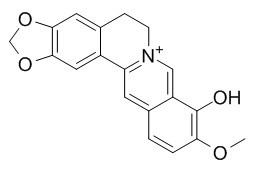Berberrubine
Berberrubine possesses diverse pharmacological activities, including glucose-lowering, lipid-lowering, anti-inflammatory, and anti-tumor effects. Berberrubine dose-dependently inhibits IL-8 and MCP-1 protein levels in the media and mRNA expression of the cells stimulated with IL-1beta or TNF-alpha.
Inquire / Order:
manager@chemfaces.com
Technical Inquiries:
service@chemfaces.com
Tel:
+86-27-84237783
Fax:
+86-27-84254680
Address:
1 Building, No. 83, CheCheng Rd., Wuhan Economic and Technological Development Zone, Wuhan, Hubei 430056, PRC
Providing storage is as stated on the product vial and the vial is kept tightly sealed, the product can be stored for up to
24 months(2-8C).
Wherever possible, you should prepare and use solutions on the same day. However, if you need to make up stock solutions in advance, we recommend that you store the solution as aliquots in tightly sealed vials at -20C. Generally, these will be useable for up to two weeks. Before use, and prior to opening the vial we recommend that you allow your product to equilibrate to room temperature for at least 1 hour.
Need more advice on solubility, usage and handling? Please email to: service@chemfaces.com
The packaging of the product may have turned upside down during transportation, resulting in the natural compounds adhering to the neck or cap of the vial. take the vial out of its packaging and gently shake to let the compounds fall to the bottom of the vial. for liquid products, centrifuge at 200-500 RPM to gather the liquid at the bottom of the vial. try to avoid loss or contamination during handling.
J Chromatogr A.2024, 1714:464544.
J Vet Sci.2020, 21(3):e39.
Foods.2023, 12(6):1227.
Kor. J. Pharmacogn.2016, 47(1):62-72
Phytomedicine.2022, 99:154025.
Biomedicines.2021, 9(8):996.
Front Pharmacol.2022, 13:870553.
Environ Toxicol.2024, 39(5):2927-2936.
Srinagarind Medical Journal2019, 34(1)
Food Chemistry: X.2022, 2022.100270
Related and Featured Products
Life Sci. 2006 Aug 1;79(10):949-56.
Effect of berberrubine on interleukin-8 and monocyte chemotactic protein-1 expression in human retinal pigment epithelial cell line.[Pubmed:
16797033]
We examined the effects of Berberrubine, a protoberberine alkaloid, on interleukin-8 (IL-8) and monocyte chemotactic protein-1 (MCP-1) expression in a human retinal pigment epithelial cell line (ARPE-19) stimulated with interleukin-1beta (IL-1beta) or tumor necrosis factor alpha (TNF-alpha).
CONCLUSIONS:
ARPE-19 cells were cultured to confluence. Berberrubine and IL-1beta or TNF-alpha were added to the medium. IL-8 and MCP-1 protein concentrations were measured using enzyme-linked immunosorbent assay. IL-8 and MCP-1 mRNA were measured by real time polymerase chain reaction. Nuclear factor kappaB (NF-kappaB) translocation was examined by immunofluorescent staining/microscopy. Berberrubine dose-dependently inhibited IL-8 and MCP-1 protein levels in the media and mRNA expression of the cells stimulated with IL-1beta or TNF-alpha. Immunofluorescent staining/microscopy of NF-kappaB in the nucleus of unstimulated cells was faint (51+/-14 arbitrary units). Fluorescein was dense (215+/-42 or 170+/-24 arbitrary units, respectively) 30 min after stimulation with IL-1beta or TNF-alpha and was decreased to 62+/-18 or 47+/-16 arbitrary units, respectively, by Berberrubine.
CONCLUSIONS:
Berberrubine dose-dependently inhibited IL-8 and MCP-1 expression and protein secretion induced by IL-1beta or TNF-alpha. Possibly, the effect on chemotactic factors may be via suppression of NF-kappaB translocation.
Bioorg Med Chem. 2010 Sep 1;18(17):6422-8.
Design, synthesis, and cholesterol-lowering efficacy for prodrugs of berberrubine.[Pubmed:
20673726]
METHODS AND RESULTS:
In order to enhance oral bioavailability of berberine (BBR) for its cholesterol-lowering efficacy in vivo, a series of ester or ether prodrugs of Berberrubine (M1), which is an active metabolite of BBR after first-pass metabolism, were designed, semi-synthesized, and evaluated. Among these Berberrubine prodrugs, compound 5g possessing palmitate at the 9-position showed a moderate LogP value and esterase hydrolysis rate for releasing Berberrubine in blood. Its cholesterol-lowering efficacy in vivo was evaluated in hyperlipidemic SD rats. Compound 5g (100mg/kg/d) reduced blood CHO and LDL-c by 35.8% and 45.5%, respectively, similar to that by BBR. It also exhibited a good safety in rats with no side-effect on liver and kidney function.
CONCLUSIONS:
Therefore, the design of Berberrubine prodrug appears to be an effective strategy to improve pharmacokinetic feature of BBR for its lipid-lowering efficacy in vivo.
Gan. 1976 Apr;67(2):321-5.
Antitumor activity of berberrubine derivatives.[Pubmed:
964560]
METHODS AND RESULTS:
The antitumor activity of berberine, Berberrubine, and their derivatives against sarcoma-180 ascites was determined by the total packed cell volume method. Berbine and tetrahydroberberine derivatives had no antitumor activity, but Berberrubine (9-demethylberberine) and the ester derivatives of Berberrubine had a strong antitumor activity. ED90 of Berberrubine, its acetate and benzoate, were 15, 23, and 44 mg/kg, respectively.
CONCLUSIONS:
The therapeutic indices (LD10/ED90 by the present method) of these compounds were as follows: Berberrubine hydrochloride, 6.7 approximately 9.4; 9-acetyl-9-demethylberberine (9-acetylBerberrubine) chloride, 7.6 approximately 8.7; 9-benzoyl-9-demethylberberine (9-benzoylBerberrubine) chloride, 3.4 approximately 4.9.
Bioorg Med Chem Lett. 2014 Apr 1;24(7):1762-5.
Synthesis and in vitro evaluation of 12-(substituted aminomethyl) berberrubine derivatives as anti-diabetics.[Pubmed:
24613165]
METHODS AND RESULTS:
By introducing various amino methyl groups into 12-position of Berberrubine, a series of 12-(substituted aminomethyl) Berberrubine derivatives were synthesized and evaluated for their anti-diabetic activity against type 2 diabetes mellitus. The results indicated that most of the prepared compounds exhibited moderate to good anti-diabetic activity, which were comparable to or even better than the berberine, the positive control rosiglitazone and insulin.
CONCLUSIONS:
Especially, compound 3b with an N-methyl piperazine-4-methyl group at C-12, exerted the most powerful anti-diabetic activity.



